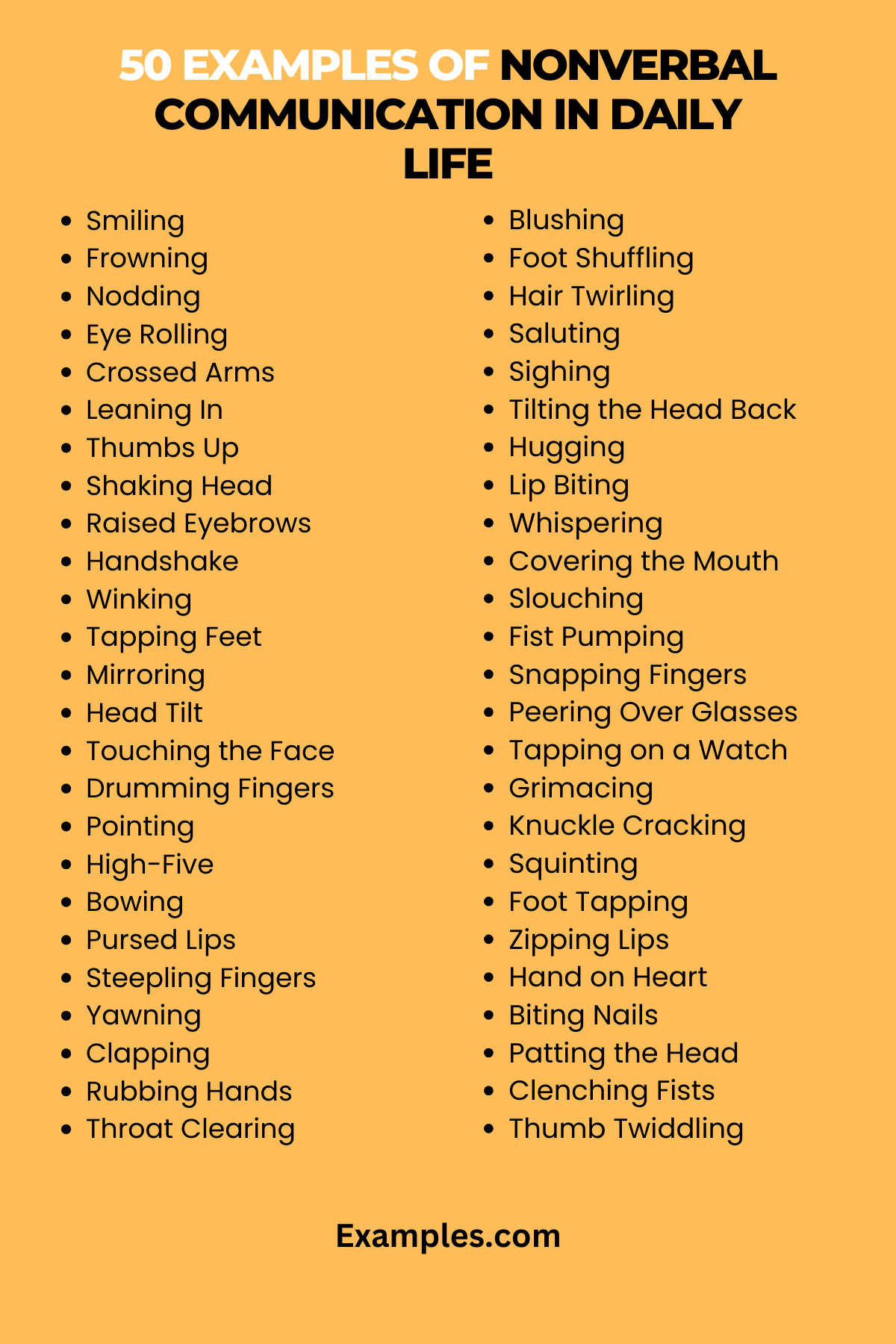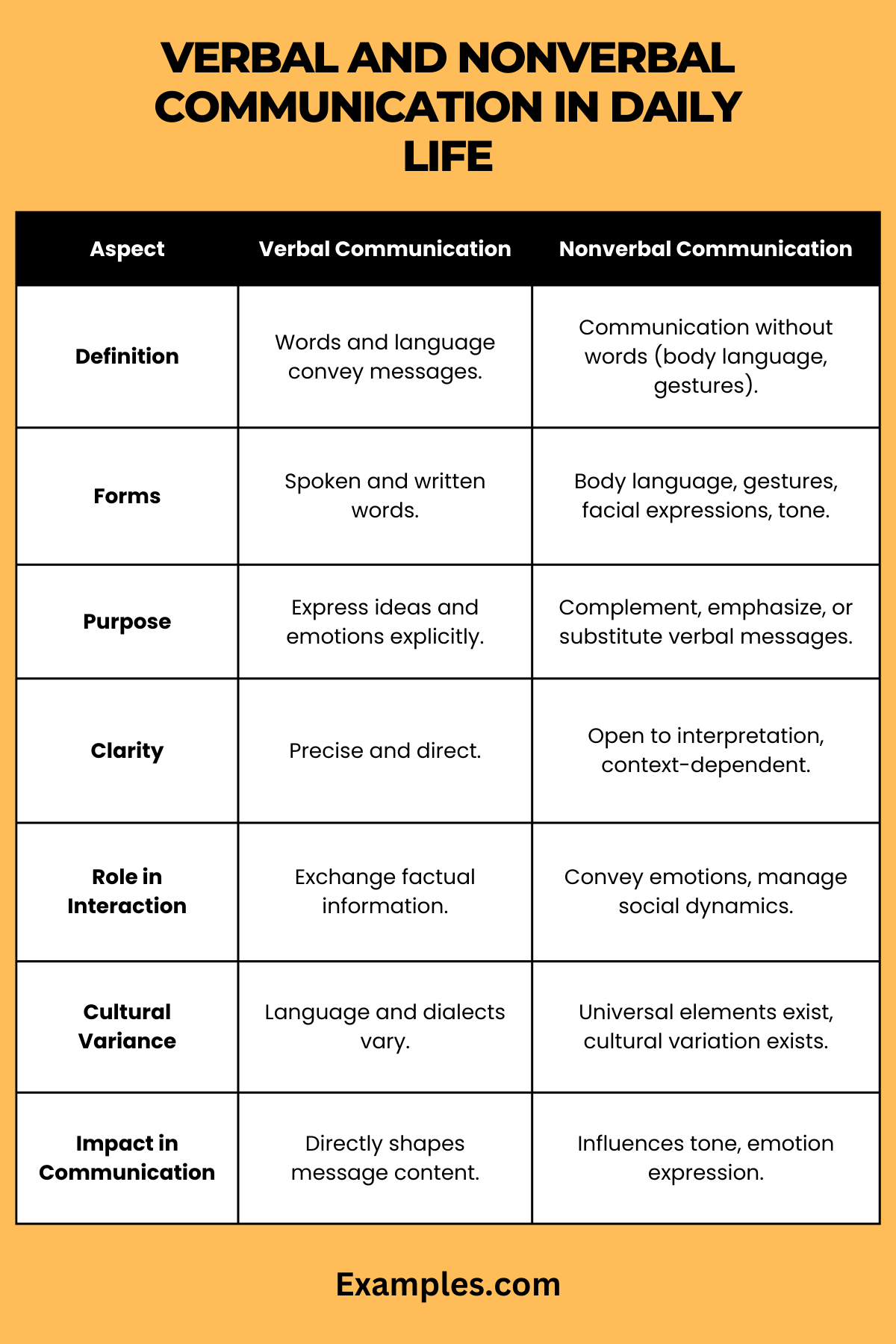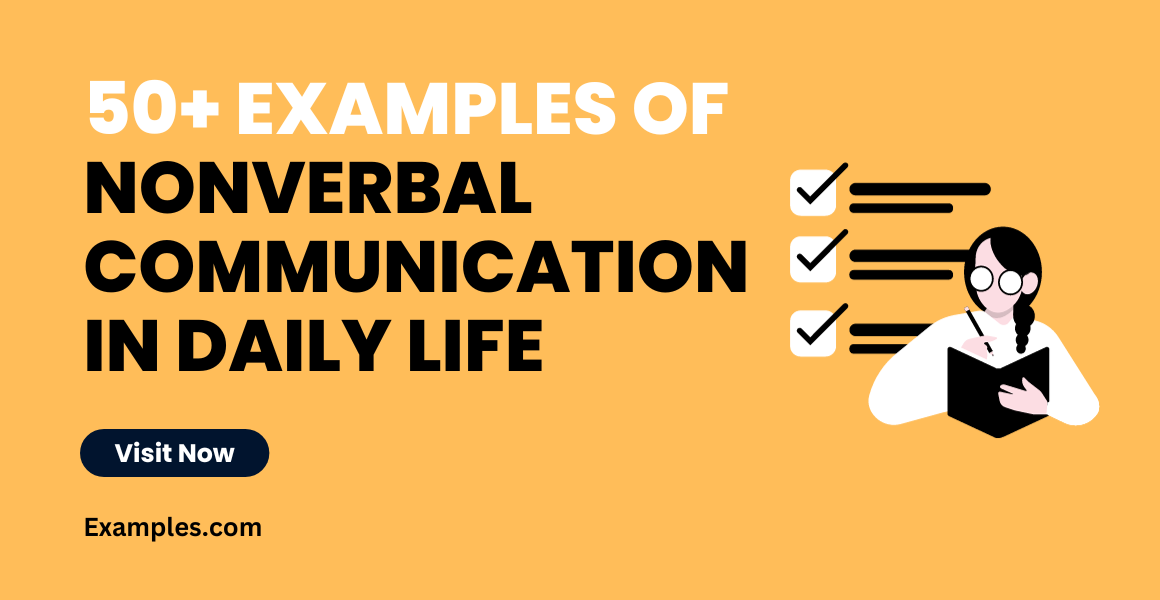49+ Nonverbal Communication in Daily Life Examples
Delving into the intricate world of nonverbal communication, this comprehensive guide highlights its profound impact in daily life. Through subtle gestures and expressive facial expressions, nonverbal cues often communicate more powerfully than words. We explore a variety of Nonverbal Communication Examples that shape our interactions and understanding, emphasizing their importance across different contexts. This guide is your window into the unspoken language that orchestrates our social and professional lives silently yet significantly.
What is Nonverbal Communication in Daily Life? – Definition
Nonverbal communication in daily life refers to the ways we convey messages and emotions without using words. It includes various forms of expression like facial expressions, body movements, gestures, eye contact, and even our tone of voice. This type of communication can reveal our true feelings and attitudes, sometimes even more clearly than spoken language. It’s a fundamental part of how we interact with others, influencing our relationships, work environment, and social encounters.
50 Examples of Nonverbal Communication in Daily Life
Nonverbal communication, a vital part of daily interactions, speaks through gestures, expressions, and body language, often louder than words. This guide, rich in Nonverbal Communication Examples and insights into Nonverbal Communication Skills, presents 50 unique examples of nonverbal cues. Each is elucidated with explanations and example sentences, offering a deep dive into the silent yet expressive world of nonverbal communication. Understand how these cues function in various contexts and learn to communicate more effectively without uttering a single word.

- Smiling: A universal sign of happiness and welcome.
Example: When meeting someone, a warm smile can communicate friendliness and openness. - Frowning: Indicates disapproval or confusion.
Example: Frowning during a presentation might show that you are not convinced by the argument. - Nodding: Shows agreement or understanding.
Example: Nodding while listening to someone speaks volumes about your engagement and agreement. - Eye Rolling: Conveys disbelief or annoyance.
Example: Rolling your eyes at an unrealistic suggestion can express your skepticism. - Crossed Arms: Often seen as a defensive or closed stance.
Example: Crossing your arms during a debate may signal that you are not open to other opinions. - Leaning In: Shows interest and engagement.
Example: Leaning in during a conversation demonstrates your attentiveness and interest in the topic. - Thumbs Up: A sign of approval or agreement.
Example: Giving a thumbs up after a successful presentation conveys your approval. - Shaking Head: Indicates disagreement or denial.
Example: Shaking your head when asked a question can nonverbally say “No.” - Raised Eyebrows: Expresses surprise or skepticism.
Example: Raising your eyebrows at a surprising fact can indicate your astonishment or doubt. - Handshake: A gesture of greeting or agreement.
Example: A firm handshake at the start of a meeting communicates professionalism and confidence. - Winking: Often implies playfulness or a shared secret.
Example: A wink during a conversation can signal a joke or an inside reference. - Tapping Feet: Can indicate impatience or nervousness.
Example: Tapping your feet during a wait shows your impatience or anxiety. - Mirroring: Copying someone’s body language as a sign of rapport.
Example: Mirroring the posture of your conversation partner can create a sense of harmony. - Head Tilt: Shows curiosity or empathy.
Example: Tilting your head while listening demonstrates interest and empathy. - Touching the Face: Can indicate thinking or uncertainty.
Example: Touching your chin or cheek often shows that you are pondering a thought. - Drumming Fingers: Suggests impatience or eagerness.
Example: Drumming your fingers on a table can indicate your eagerness to proceed. - Pointing: Used to direct attention or assert a point.
Example: Pointing to a document can emphasize an important section. - High-Five: A gesture of celebration or agreement.
Example: Giving a high-five after a successful team effort shows camaraderie and agreement. - Bowing: A sign of respect in many cultures.
Example: A bow in certain cultures can be a respectful way to greet or thank. - Pursed Lips: May indicate disapproval or skepticism.
Example: Pursed lips during a conversation might suggest skepticism or disagreement. - Steepling Fingers: Often seen as a gesture of confidence or authority.
Example: Steepling your fingers during a meeting can signal confidence in your ideas. - Yawning: Indicates tiredness or sometimes boredom.
Example: Yawning in a meeting, though sometimes involuntary, can suggest boredom or fatigue. - Clapping: Shows appreciation or agreement.
Example: Clapping after a presentation indicates your appreciation for the speaker’s effort. - Rubbing Hands: Implies anticipation or excitement.
Example: Rubbing your hands together can show your anticipation for an upcoming event. - Throat Clearing: Can signal discomfort or a desire to speak.
Example: Clearing your throat might be a subtle way to gain attention before speaking. - Blushing: Often a sign of embarrassment or shyness.
Example: Blushing when complimented can indicate modesty or embarrassment. - Foot Shuffling: Indicates discomfort or the desire to leave.
Example: Shuffling your feet during a conversation might show your discomfort or impatience. - Hair Twirling: Can be a sign of thoughtfulness or nervousness.
Example: Twirling your hair often happens when you’re deep in thought or feeling nervous. - Saluting: Indicates respect or acknowledgment in military contexts.
Example: A salute in a military setting is a formal way to show respect. - Sighing: Can express relief, frustration, or sadness.
Example: Sighing after completing a task can signify relief or exasperation. - Tilting the Head Back: May indicate arrogance or contemplation.
Example: Tilting your head back can be perceived as a sign of arrogance or deep thought. - Hugging: Shows affection, comfort, or consolation.
Example: A hug can convey comfort and support in times of distress. - Lip Biting: Often a sign of anxiety or concentration.
Example: Biting your lip can indicate nervousness or deep concentration. - Whispering: Used for confidential or intimate communication.
Example: Whispering in someone’s ear can convey a sense of privacy and intimacy. - Covering the Mouth: Can suggest surprise, shock, or the desire to hide an emotional reaction.
Example: Covering your mouth in surprise shows a spontaneous reaction to unexpected news. - Slouching: Often seen as a sign of laziness or disrespect.
Example: Slouching in your chair can come across as uninterested or disrespectful. - Fist Pumping: Indicates triumph or excitement.
Example: Pumping your fist in the air can show victory or excitement. - Snapping Fingers: May signal impatience or a request for attention.
Example: Snapping your fingers can be a way to call for someone’s attention quickly. - Peering Over Glasses: Can imply scrutiny or disbelief.
Example: Peering over your glasses at someone can suggest that you are closely scrutinizing what they say. - Tapping on a Watch: Implies that time is of the essence or a reminder of time constraints.
Example: Tapping your watch during a meeting can indicate the need to be mindful of the time. - Grimacing: Shows displeasure or pain.
Example: Grimacing can visibly demonstrate discomfort or disapproval in a situation. - Knuckle Cracking: May be a sign of nervousness or a habitual gesture.
Example: Cracking your knuckles can be an unconscious habit or a way to release nervous energy. - Squinting: Often indicates difficulty seeing or skepticism.
Example: Squinting at a document can suggest you are having trouble reading it or are doubtful about its content. - Foot Tapping: Signifies impatience or a lively rhythm.
Example: Tapping your foot to music shows your enjoyment of the rhythm. - Zipping Lips: Symbolizes the need for secrecy or refusal to speak.
Example: Mimicking zipping your lips can indicate the importance of keeping information confidential. - Hand on Heart: Indicates sincerity or a solemn promise.
Example: Placing your hand over your heart can show sincerity and commitment. - Biting Nails: Often a sign of anxiety or nervousness.
Example: Biting your nails is a common response to nervous or stressful situations. - Patting the Head: Can be a sign of affection or condescension.
Example: Patting someone on the head can be a loving gesture or, in some contexts, patronizing. - Clenching Fists: Indicates anger, determination, or frustration.
Example: Clenching your fists can visibly show strong emotions, like anger or resolve. - Thumb Twiddling: Signifies boredom or idleness.
Example: Twiddling your thumbs is often a sign of having nothing to do or feeling bored.
How is Nonverbal Communication Used in Our Daily Life?
Nonverbal communication, an essential facet of human interaction, silently orchestrates our everyday social exchanges and plays a pivotal role in how we connect and communicate. It encompasses a myriad of cues like gestures, facial expressions, body language, and even the tone of our voice. In our daily lives, these nonverbal elements serve multiple functions. They not only help in expressing emotions and feelings more vividly but also assist in enhancing the meaning of verbal messages.
From a nod of agreement during a conversation to a firm handshake in a business meeting, nonverbal cues are integral to the way we interact, build relationships, and understand each other. They add nuance and depth to our communications, often conveying messages that words alone cannot. By recognizing and interpreting these signals effectively, we navigate social interactions more smoothly, making nonverbal communication a key component in our daily life.
Importance of Non-verbal Communication in Everyday Life
The importance of non-verbal communication in everyday life is profound and multifaceted. It is a silent yet powerful mode of communication that greatly influences our interactions and relationships. Nonverbal cues like body language, facial expressions, and eye contact play a crucial role in adding context and depth to our conversations, often conveying messages more powerfully than verbal communication.
They serve as a mirror reflecting our true emotions and intentions, often bypassing the limitations of language barriers. In personal relationships, a gentle touch or a reassuring smile can convey care and empathy more effectively than words. In professional settings, body language and appearance significantly impact how we are perceived and can dictate the course of our interactions. For people with communication challenges, such as those with hearing impairments or autism, nonverbal communication is indispensable. It not only aids in expressing themselves but also in understanding others. Thus, non-verbal communication is not just an adjunct to verbal expression; it is a fundamental aspect of how we connect, understand, and relate to one another.
Types of Nonverbal Communication in Daily Life
Nonverbal communication in daily life manifests in various forms, each playing a unique role in how we express ourselves and interpret others. Understanding these types can enhance our communication skills and improve our interactions. Here are the primary types:
- Facial Expressions: Perhaps the most direct and powerful form of nonverbal communication, facial expressions can convey a wide range of emotions, from happiness to anger, without a single word.
- Body Language and Posture: The way we sit, stand, and move can communicate confidence, openness, or defensiveness, greatly influencing how others perceive us.
- Gestures: Hand movements and gestures, such as waving, pointing, or using sign language, are essential for conveying messages, especially in situations where verbal communication is limited.
- Eye Contact: The act of making or avoiding eye contact can convey levels of engagement, interest, or respect, and is crucial in establishing connections.
- Touch: A handshake, hug, or pat on the back can communicate a range of emotions and intentions, from greeting to comfort or reassurance.
- Paralanguage: This includes aspects of voice other than speech, such as tone, pitch, and volume, which can alter the message’s meaning and impact.
- Proxemics: The physical distance maintained in interactions, known as proxemics, can indicate the level of intimacy, comfort, or power dynamics between people.
- Appearance: Our choice of clothing, accessories, and grooming style can communicate various aspects of our identity, status, and even mood.
- Silence: Often overlooked, silence can be a powerful tool in communication, used to convey contemplation, disapproval, or agreement.
By understanding and effectively utilizing these types of nonverbal communication, we can enhance our ability to communicate and connect with others in our daily lives.
Verbal & Non-Verbal Communication in Daily Life
Communication is the cornerstone of our daily interactions, and it takes two primary forms: verbal and non-verbal. While words are a vital part of how we convey information, they are only one piece of the puzzle. Non-verbal communication, often underestimated, wields incredible power in shaping our social encounters.

In this section, we explore the dynamic interplay between verbal and non-verbal communication in our daily lives. We delve into the distinct characteristics of each, their roles in conveying messages and emotions, and how they combine to create rich, nuanced interactions. From the spoken word to the unspoken cues of body language, we unravel the intricate tapestry of human communication and its profound impact on our relationships, emotions, and understanding of the world.
| Aspect | Verbal Communication | Non-Verbal Communication |
|---|---|---|
| Definition | The use of words and language to convey messages. | Communication without words, using body language, facial expressions, gestures, and more. |
| Forms | Spoken words, written text. | Body language, facial expressions, gestures, eye contact, touch, paralanguage (tone, pitch), proxemics (distance). |
| Purpose | To articulate ideas, thoughts, and feelings explicitly. | To complement, contradict, or substitute verbal messages, often conveying emotions and attitudes. |
| Clarity | Can be more precise and direct. | Often open to interpretation, depending on context and cultural norms. |
| Role in Interaction | Primary method for exchanging factual information. | Crucial for expressing emotional states and managing social dynamics. |
| Cultural Variance | Language and dialects vary significantly across cultures. | While universal elements exist, many non-verbal cues are culturally specific. |
| Impact in Communication | Directly impacts the content of the message. | Influences the tone and perceived sincerity of the interaction. |
What is the Role of Nonverbal Communication in Daily Life?
The role of nonverbal communication in daily life is multifaceted and profound. It functions alongside verbal communication to enrich our interactions and understanding of one another. Key roles include:
- Enhancing Verbal Communication: Nonverbal cues often complement and reinforce verbal messages, helping to clarify and strengthen the communication.
- Conveying Emotional States: Nonverbal signals are crucial in expressing emotions and attitudes that might be difficult to articulate in words.
- Facilitating Social Transactions: Nonverbal communication is vital in social interactions, assisting in forming first impressions, building rapport, and establishing trust.
- Regulating Interactions: Nonverbal cues help to manage the flow of conversations, indicating when it’s appropriate to speak or listen.
- Substituting Verbal Messages: In situations where verbal communication is not possible, such as in loud environments or for people with speech impairments, nonverbal communication becomes the primary mode of expression.
- Reflecting Cultural Values: Nonverbal communication varies across cultures, reflecting and reinforcing cultural norms and values.
Understanding the role of nonverbal communication can greatly enhance our ability to interact effectively, navigate social environments, and build relationships in our daily lives.
In conclusion, examples of nonverbal communication in daily life are abundant and impactful, enhancing our interactions in profound ways. This guide has provided insights, tips, and practical examples to help navigate this silent language effectively. By understanding the nuances of nonverbal cues, we can foster better connections, convey emotions authentically, and enrich our daily communication experiences.



